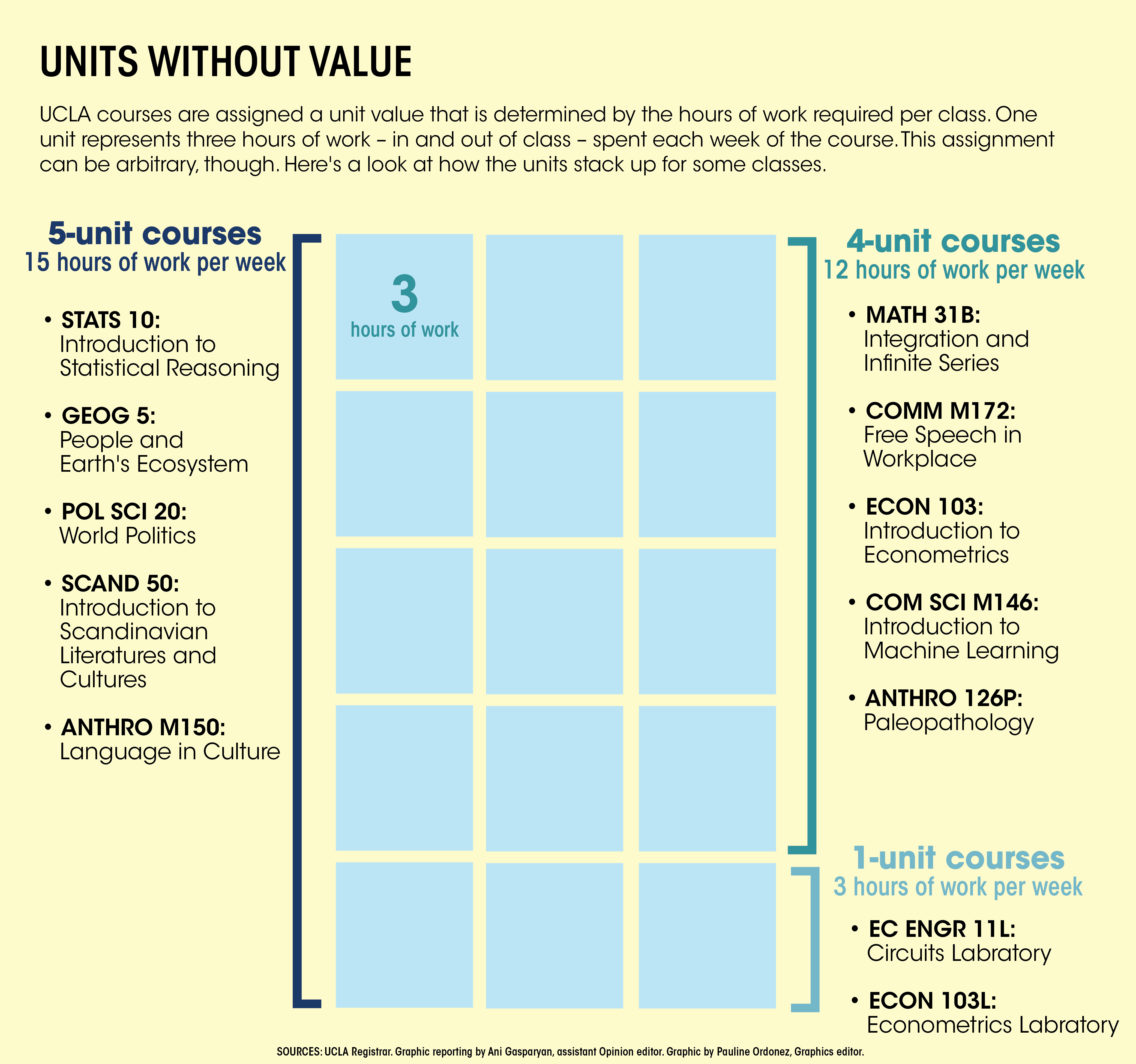Poor correlation between course load and unit count causes confusion among students

By Sandra Wenceslao
April 29, 2019 10:52 p.m.
UCLA is a place where numbers don’t work outside of a math class. It’s a place where four equals seven and five equals three.
When it comes to course units, that is.
The number of units for each class is determined by its attendance, classwork and additional weekly assignments outside of class. This number is based on the instructor who drafts the course proposal and how much time and effort they believe a student must put into a course, said Eric Wells, a committee analyst for the Academic Senate.
But the units often don’t accurately represent the amount of work and time students spend on a course. Course instructors change from one quarter to the next, and the assignments with them. There aren’t any set limits or standards for classes – it all depends on what a professor perceives to be the necessary time and effort.
This inconsistency allows some professors to require a lot from students who earn fewer units than they should.
UCLA’s unit designations aren’t accurate reflections of a student’s time and effort. These inaccurate numbers can give students a false expectation of the coursework they sign up for during enrollment, leading them to experience undue stress and distaste for their quality of education.
Each unit represents three hours of work per course each week. A student who enrolls in a four-unit course theoretically should expect to spend about 12 hours per week either in class or doing work for it.
Wells said classes often range from four to five units, but that it’s difficult to put a number on student engagement and overall time spent per course.
“I believe it is extremely challenging to gauge student time investment,” Wells said. “(For example), reading more technical subjects or dense material would likely take more time to read and digest than other subjects.”
These varying factors make it hard to prescribe a consistent value to course units.
But giving professors the power to determine freely the amount of coursework assigned can be an issue itself. There is too much variability in how unit counts are assigned to courses. The same course can be taught by different professors in the same year, leaving some students putting significantly more time into one class than their other classes.
But more time doesn’t necessarily mean more units.
Teresa Dueñas, a third-year biology student, said she remembers taking three- and four-unit classes that assigned a lot more work than five-unit courses.
“Sometimes it was more (work) than five-unit classes,” she said. “Honestly, for those classes, I was doing a lot. I’d spend a whole day just doing work for that class.”
Students taking classes with fewer units but large course loads might have to sacrifice extracurricular activities or a job midway through the quarter because they can’t keep up. This can be detrimental to students as they might be steering away from a requirement or take more than the recommended courses per quarter.
Elena Stevens-Flores, a fourth-year psychology student, said she took a three-unit lab course over a summer, which was a psychology degree requirement at the time.
“I felt like (the work we did) was a lot, but I also was taking three other classes,” she said. “If the unit count was higher, I feel like I would’ve taken only three.”
This kind of situation can steer students away from lower-unit courses, and thus hurt their educational experience.
“I feel like I’ve had a bad experience with (four-unit classes),” Dueñas said. “So if I’m going to do so much, then I’m going to go ahead and do it for more credit in a five-unit class.”
There’s a lot of difference one unit can make. Students’ graduation statuses rely significantly on whether they’ve met a certain unit count. Taking a four-unit course that leaves them with too much on their plate compared to a five-unit one that requires little of them can change their course schedules dramatically.
“It kind of seems like, ‘What’s the point if it’s one less?’ What if you need that one unit to graduate?” said Sarah Demma, a third-year English student.
Of course, it is difficult to hold instructors accountable for giving students only the amount of work they signed up to do for the course. Yet, as Wells said, all academic programs are reviewed every eight years by the Academic Senate. Making this review a process that happens more frequently would be the first step in making sure units aren’t arbitrary.
It’s about time UCLA makes unit counts speak for the coursework students are signing up for. Let’s make the numbers make sense.

